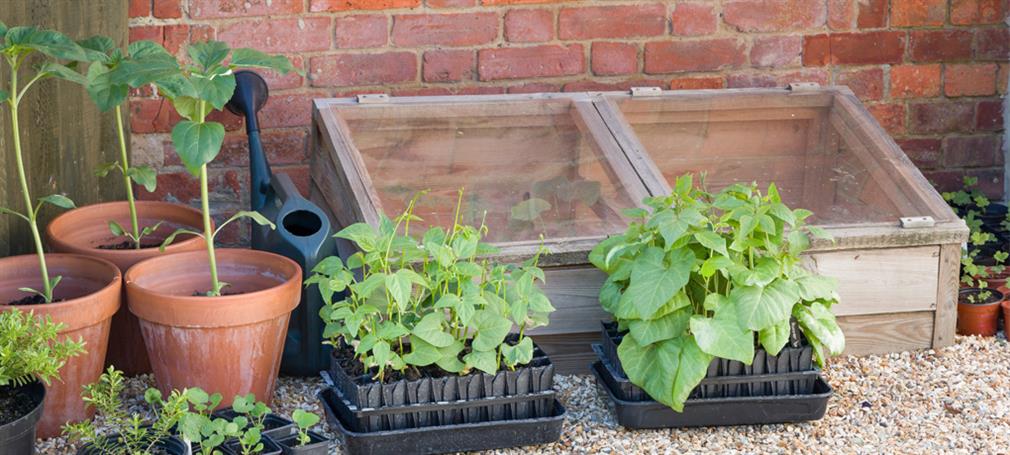How to use your cold frame all year

For most garden owners, the garden season ends somewhere around when the autumn is ending and the winter begins. What if you could extend this period with two months or even more? You can if you use a cold frame – or two. Then you can enjoy all sorts of fresh green produce all through winter -more or less. Wouldn’t that be something? You may have heard about it – if not, allow us to introduce you to the concept of cold frame gardening.
Welcome to cold frame gardening
As you know, a cold frame is more or less just a small greenhouse with windows on all sides where you can grow all sorts of plants. By creating a warm environment, you can extend the growing season of a wide range of plants. You may want to build the cold frame yourself – then see paragraph about How to… Another easier solution is to order one or more cold frames from Dancover. You can assemble the cold frame(s) in no time and you do not have to worry about maintaining anything as they are made of aluminium and polycarbonate.
How does a cold frame work?
A cold frame is like a small greenhouse where the construction can protect the plants inside against the sometimes rough or cold weather in the early spring, autumn and winter. It shelters the plants from snow, rain, strong winds, hail and ice. Because the lid or roof and sides are transparent, the sunrays can get inside warming up the cold frame. A cold frame will often be about 5-10 degrees warmer inside than the temperature outside. That is why your seeds or sprouts will grow into plants despite the cold weather around the cold frame. It is important that the climate inside the cold frame is regulated so it does not get too hot – do not underestimate the power of the sun all year round. You can consider installing an automatic window opener, which will open the lid when the temperature reaches a certain temperature. Or you can just open the lid yourself when required.
Why you should have a cold frame …
Just because it is great fun to grow your own plants. Especially if you do not have room for a large greenhouse. Even though you do have a greenhouse, a cold frame can help you grow all sorts of plants from the early spring and beyond. The cold frame is also great in the autumn. Use the warm place for keeping plants dormant during the last of winter. The flexible and moveable solution is cheaper than a greenhouse.
… and a few arguments against
Because of the size you cannot have as many plants as you may want. You can have more than one cold frame, but a greenhouse simply provides more room – and then you can enjoy going inside the greenhouse to nurse your plants. There is not that much air inside a cold frame, and the humidity takes a little more to manage. On days where the temperature fluctuates, you have to take more care of the cold frame – and finally, you need to water quite often – especially in warm weather. When that being said, you can enjoy your cold frame most of the year for a great variety of different plants.
Cold frames all year round
Cold frames in the spring
We all know that a cold frame is perfect for growing all kinds of plants in the spring – from seeds or sprouts. Inside the cold frame, the plants will thrive from the early spring when the first rays of sun will warm up the small greenhouse. The plants need to toughen up before you can move them into the garden. By toughen up we mean to acclimatise the plants to most kinds of weather conditions, higher or lower humidity and increased air movement. This is important before you can move the plants from the cold frame. In short, this time of year, the cold frame serves as the in-between stage when you are transferring the plants from inside your house to the garden.
Cold frames in the summer
Using the cold frame in the summer allows you to provide certain plants with more heat before the season actually starts. This is very useful when planting, for example, tomatoes and chillies. The increased warmth from the cold frame will encourage and speed up their growth. You can also use the cold frame for propagating plants – and not only in the early spring! The plants will be well protected against too much heat or heavy rain. Plant seeds, cuttings with new roots or young plants and adjust the conditions inside the cold frame according to the needs of your new plants.
Cold frames in the autumn
Many garden owners will not think about their cold frames when the autumn sets in. That is a mistake. In the autumn, your cold frame can protect the young plants and cuttings from sudden change in the weather like early snow or degrees below zero at night. By using a cold frame in the autumn, you can extend the harvest season by 4 weeks or more. Did you know that you can grow lots of plants in your cold frame in the autumn. Plants like arugula, broccoli, beets, cabbage, carrots, chard, cabbage, green onion, kale, lettuce, pak choy, radish and spinach – just to mention some. Lots of good vitamins so you are ready for winter.
Cold frames in the winter
A little depending on where you live, you can use the cold frame during the winter for – among other things - carrots, claytonia, kohlrabi, mache, parsley, radicchio, scallion and spinach. You should start the crops for winter late summer and early autumn. The plants should reach near full growth before the first freeze or snow. The plants will not continue to grow after this but will stay well-protected and dormant inside the cold frame. You can then go outside and harvest the things you need during the winter.
Another thing you can use your cold frame for is protecting your alpines against too much rain and snow, which sometimes can make them rot. Keep the small and tough plants in the cold frame so they are ready for the next garden season in a short while. In case of severe frost, you can line your cold frame with bubble wrap. Just be aware that using bubble wrap will reduce the light and ventilation somewhat.
Some delicious cold frame winter produce
Like with so many things in the garden, you get a little wiser every year – and so many different things play a part in producing healthy plants and making them thrive. In general, we focus on the spring for new plants, but many plants will grow nicely even when you start a lot later – check the package or the internet before ordering. Here we have a short list of plants you can try growing in your cold frame from the autumn and forward:
Arugula, broccoli, beets, cabbage, carrots, chard, Chinese cabbage, green onion, kale, lettuce, mache, pak choy, radish and spinach…
Get the most out of your cold frame
It may be a little difficult to find some of the mentioned seeds in your garden centre so late in the summer or in the beginning of autumn. That is because most people use them in the spring. Otherwise, they should be available online if your local plant centre or nursery cannot help. If you plan a little ahead, just order the seeds in the spring and save them.
Inside a cold frame or in a greenhouse you can extend the garden season as the temperature can be somewhat higher for a while. So that is why you can grow many different kinds of salads and healthy veggies. A little depending on the temperature, you should be able to get fresh food until sometimes in the beginning of December a little depending on the temperature. If you have a greenhouse, you can turn on a heater and extend the season even longer. You can also insulate the cold frame with bubble wrap – or for a more environmentally friendly solution - bales of hay. Just make sure that you do not cover for the light. Using horse or chicken manure as fertilizer will also create a little heat and energy for the plants.
When you grow vegetables in the autumn, you do not have to spend time watering them. There should be enough moist in the ground. If you grow the vegetables inside a greenhouse, you may have to water even if the plants are growing directly in the ground.
There is a reason that global warning often is called the greenhouse effect – and the same principle goes for a cold frame. Heat can very easily build up inside a cold frame so your plants will thrive. However, you need to keep an eye on the temperature and humidity and open the lid so the plants will have a pleasant climate at all times. A nice temperature during the early autumn could be around 18 degrees during the day and 10-15 during the night. In winter, when the plants have matured, you can expect degrees from 1 to 5 degrees and somewhat lower at night. For periods with colder weather, you may consider to insulate the cold frame.
How to pick the perfect place for your cold frame
When you want the full effect from using a cold frame, be sure that the cold frame is placed somewhere with direct sunlight all day if possible. The whole idea of the structure is to gather sunlight and warmth so the plants will grow and thrive. In general, the cold frame should face south. If these conditions are fulfilled, you can have the cold frame more or less anywhere – against a shed, garage, greenhouse, your house or next to the patio for easy access. If you need the cold frame mostly for growing cuttings, be careful not to have too much sunlight but somewhere with a little more shade.
How to capture more heat in your cold-frame
There are a few tricks to make the most of the sun if you live in a cool climate with not that much sun every day. If you build your cold frame, paint the inside of the frame white. Another solution is to cover it with aluminium foil. Then it will reflect the sun rays all day, ensuring enough sunlight. This is not necessary if you order one of the cold frames in our shop as they are aluminium. You can also place one or more black water bottles inside the frame. During the day, they will warm up and release warmth for a long time after the sun has stopped shining.
Keep your cold frame clean and tidy/strong
Like in a greenhouse, it is important to keep everything nice and clean in and on the cold frame. Always make sure to remove leaves and other things on top of the frame. In the autumn you should remove leaves and more on a regular basis. During winter, make sure to remove snow on the lid by using a soft broom. The main idea is to get rid of everything that might block the light so the plants do not get the life-giving sun.
How to build a cold frame
If you are a DIY-person, you should be able to build a cold frame yourself. You can use new or re-used wood and maybe some old windows. Another option is to make a frame and then make a lid covered with our sturdy greenhouse film. Just make sure that you can open and close the lid when needed so you can regulate the temperature inside the cold frame.
Most people use wood, but you can build a cold frame with bricks, polycarbonate, straw bales and more. Just make sure that it is sturdy and strong so it can shelter and protect the plants from strong wind and heavy rain. If you cannot get hold of an old window or glass door, you can fasten a sheet of glass or polycarbonate to a wooden frame. To make it easy to open the lid, add a handle and make it possible to keep the lid open when you need to nurse the plants and more.
If you do not want to spend time building the cold frame yourself, or you prefer a design that is somewhat more elegant, you can order one of our cold frames made of durable and maintenance-free materials. Then you can focus on the plants and start looking forward to all sorts of delicious vegetables and wonderful flowers for many months each season.
- Talk with an Expert 22 888 06 80
- Chat with an Expert
- Get a call from an Expert
- Buy now


























